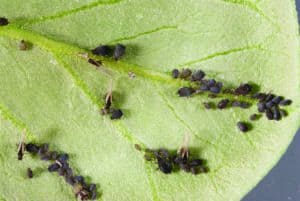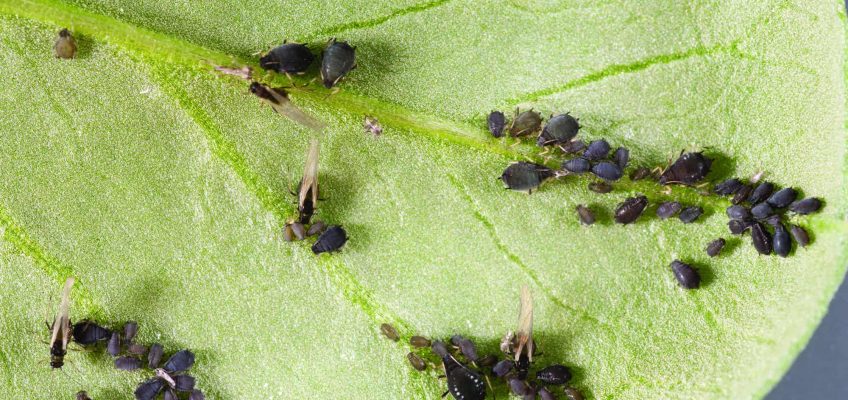As part of our readiness and response obligations under GIA we are profiling a number of priority pests. Black Bean Aphid is not currently in New Zealand but it’s important that we all have a good understanding off the threat Black Ban Aphid could pose, if it gets to New Zealand.

Black bean aphid is very polyphagous and feeds on more than 200 cultivated and wild plant species on which it spends the summer, including many crop plants such as, spinach, beans, runner beans, celery, potatoes, sunflowers, carrots, artichokes, tobacco and tomatoes.
Black bean aphid (Aphis fabae) is widespread in temperate regions of the northern hemisphere (Europe, USA, Canada, Mexico, Asia, Middle East), South America and Africa. It is predominantly a crop pest in temperate and Mediterranean climates but also occurs in the Middle East, India and in some countries in South America and Africa. It is uncommon in most tropical regions and is presently absent from Australasia. The closest countries to New Zealand where it is found are Malaysia and the Philippines.
Given the distances between New Zealand and the closest countries where Black bean aphid occurs, it is most likely that introduction pathways are limited to the pathways for distribution of host plants. These include movement of host plants in commercial consignments. The main means of dispersal of A. fabae is through migratory flight.
The primary host of Black bean aphid is usually Euonymus europaeus(European spindle) – a species of flowering plant native in Europe. Euonymus europaeus is present in NZ, recognised as a weed species.
Economic damage is mainly due to direct feeding damage. Indirect damage is caused through the transmission of plant viruses. Feeding damage by Black bean aphid is of greater economic significance than virus transmission.
Direct feeding damage results in loss of sap and injury to plant tissues. Young plants are particularly vulnerable. Plants may be stunted and may die under heavy attack. Leaves may appear wilted. Seed formation is subsequently reduced. Indirect damage occurs through virus spread. Dense colonies of Black bean aphids are visible on upper stems and the undersides of leaves, in beans and other crops and are often ant-attended. Young colonies consist of matt black aphids on younger shoots, while older colonies spread over most aerial plant parts. Older colonies include many individuals with white wax markings.
To obtain enough protein, aphids need to suck large volumes of sap. The excess sugary fluid, honeydew, is secreted by the aphids. It adheres to plants where it promotes growth of sooty moulds and other fungi. These are unsightly, reduce the surface area of the plant available for photosynthesis and may reduce the value of the crop.
Black bean aphid transmits over 30 disease causing viruses to plants, including beans and peas, beets, chilli peppers, crucifers, cucurbits, Dahlia, potato, tobacco, tomato, tulip, lucerne and iris. Black bean aphid is, however, a relatively poor vector of plant viruses, compared with other economically-important aphids such as Green peach aphid. The following viruses are vectored by Black bean aphid: Bean common mosaic necrosis virus, Bean common mosaic virus, Bean leafroll virus, Bean yellow mosaic virus, Beet mosaic virus, Beet yellows virus, Cowpea aphid-borne mosaic virus, Faba bean necrotic yellows virus, Maize dwarf mosaic virus, Pea seed-borne mosaic virus, Plum pox virus, Potato leafroll virus, Potato virus S, Potato virus Y, Soybean mosaic virus, Tobacco etch virus, Tulip breaking virus. Additionally, it’s thought that it vectors PVA, and PVY.
As potato plants are not the most preferred host, winged Black bean aphids tend to feed on them just for sustenance. They will move to multiple plants, spreading PVY, as they seek their preferred host to colonise. Overseas experiences of trapping in potato crops tend to find large numbers of winged Black bean aphids, along with other potato aphids.
Black bean aphid has a potentially enormous multiplication rate under favourable environmental conditions, enabling rapid exploitation of hosts. Warm spring temperatures favour population growth. Rainfall has little effect, although strong rain and wind can destroy colonies. This aphid tends to colonize field edges, where the most severe crop losses occur, via the influence of wind on initial colonisation. Natural enemies can limit population growth, although only in exceptional years.
The Black bean aphid has both sexual and asexual generations in its life cycle and thrives best at temperatures around 14-15°C. However, the different subspecies perform better under different environmental conditions. The optimal weather conditions and broad distribution of host plants mean that the potential for establishment and spread of Black bean aphid in New Zealand is very high.
Natural predators of Black bean aphids include both adults and larvae of ladybirds and lacewings and the larvae of hoverflies. Certain species of tiny parasitic wasps lay their eggs inside aphids and the developing wasp larvae devour their hosts from inside. Members of the wasp genera Diaeretiella and Lysiphlebus behave in this way and may provide a measure of control of the aphids.
Primary forms of cultural control include destruction of crop residue immediately after harvest. Avoiding other aphid-favoured crops, such as lettuce, in adjacent, upwind fields. Intensify field monitoring for aphids when adjacent fields with aphid-favoured crops are harvested. Cultural controls can reduce the spread of virus through seed potatoes with, seed potatoes grown during periods of zero or low aphid population; alternative food plants of aphids not be grown in proximity to potato seed crops; insecticide applications be timely and at the correct dose; diseased plants should be removed; and potato foliage should be removed as the crop approaches maturity to avoid infestation by aphids.
In several European countries, insecticide applications are based on aphid warning schemes or aphid forecasting systems. Aphid flights are caught in suction traps.
Information sourced from AUSVEG March 2017.



